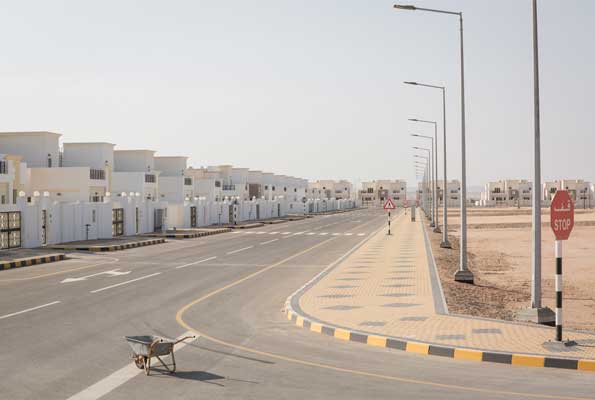According to information from the National Centre for Statistics and Information (NCSI), Oman saw real estate transactions of USD 1.2 billion (OR447.3 million) in February 2023.
The amount reflects a 17.4% rise over the USD 990 million (OR381.1 million) from 2022.
USD 32.5 million (OR12.5 million) was the total fees received from all legal cases, an increase of 22.8% from 2022. Sale contracts were worth USD 539 million (OR207.5 million), while mortgage contracts were worth USD 619 million (OR238.3 million).
The swap contracts were worth USD 3.9 million (OR1.5 million). By the end of February 2023, there were 39,079 title deeds in existence, according to NCSI figures.
The number of title documents granted to Gulf Cooperation Council (GCC) citizens increased by 41.9% to 210 from 148 at the end of January 2022.
The Steady Growth Of Non-Oil Sectors
The year 2023 will likely see the Sultanate of Oman’s non-oil sector increase steadily. A survey from the Institute of International Finance (IIF) also predicts that the Sultanate of Oman’s non-oil economy will increase by 2.4% in 2023 as opposed to 2% in 2022.
The institute emphasized how resilient the GCC nations are in facing external challenges.
In a recent report, the institute claimed that the expected increase in non-oil income and ongoing spending restraint might balance out the decline in oil exports to the Gulf Cooperation Council nations, which in turn results in a reduction in the price of oil required to balance the budgets of the Gulf nations.
According to the institution, the price of oil fell from USD 100 per barrel in 2022 to USD 85 in 2023 and USD 80 in 2024.
The research continued that the likelihood of sluggish global economic growth represents the primary downside risk to the oil price outlook.
By the end of 2023, the IIF forecasted that the GCC countries’ total foreign assets would amount to nearly USD 3.3 trillion, or 145% of their GDP.
Declining Inflation
Due to government subsidies, price controls on specific goods, and a strengthening US dollar, Oman’s annual inflation, which remained relatively low in 2022 despite growing worldwide inflation, is anticipated to slow down even further in 2022.
The International Monetary Fund (IMF) projects that Oman will have the lowest projected inflation in the GCC in 2023, recording an average inflation rate of 1.9%, down from one of the lowest rates among GCC nations in 2022.
The Oman inflation rate dropped to 1.6% in March 2023 from 1.9% the previous month, the lowest monthly since June 2021. Following Saudi Arabia, which recorded an inflation rate of just 2.5% for the year, the sultanate had the second-lowest average inflation rate among GCC nations in 2022, at 2.8%.
With an average of 2.9% in 2023 and 2.3% in 2024, the IMF anticipates further declines in GCC inflation over the next two years.
According to a research report published by Kuwait-based Kamco Investment, “lower inflation in GCC countries is mainly attributed to government interventions such as price caps on certain products, subsidies on key products or utilities, and the strengthening of the US dollar, which all GCC countries have pegged to their currencies, except for Kuwait, which has linked its currency to a basket of currencies including the US dollar.”
The food and beverage category has been among the most significant categories regarding weight or growth in Oman’s and the GCC’s inflation performance regarding the sectoral inflation trends. All GCC nations have seen growth in the food and beverage sector.
The food and non-alcoholic beverage index, the second-largest weighted index, increased by 4.1% yearly in March 2023, a significant contributor to Oman’s inflation rate.
Housing-related inflation rise was uneven among GCC nations. However, it tended to increase year over year in March 2023. Qatar experienced the most significant growth in housing costs among the GCC nations in the same time, rising by 8.7%. In contrast, Oman’s house prices were unchanged in March 2023 compared to the same month in 2022.
The Kamco Investment report also states that another important factor that has kept GCC inflation rates significantly lower than their global counterparts is the combination of persistently high energy prices and interest rate increases by GCC central banks, mainly in unison with the US Federal Reserve rate increases.
The US Federal Reserve has been keeping on raising interest rates to fight inflation. The Fed raised interest rates for the ninth time since March 2022, by hiking the benchmark overnight rate by 0.25 basis points to a range of 5.0–5.25%.
All GCC central banks have raised their benchmark rates in reaction to the Fed’s rate hike. Due to the Omani rial’s tie to the US dollar, the Central Bank of Oman recently raised its repo rate by 25 basis points to 5.75%. Since March 2022, the Omani central bank has raised interest rates ten times.
The drop in world food prices significantly contributes to the fall in GCC inflation. March 2023 marked the 12th month in a row that the Food and Agriculture Organization’s (FAO) primary food price index fell.
The FAO index tracks the most widely traded food items. The FAO index dropped 20.5% from its peak level at the outset of the Russia-Ukraine war to an average of 126.9 points in March 2023.



